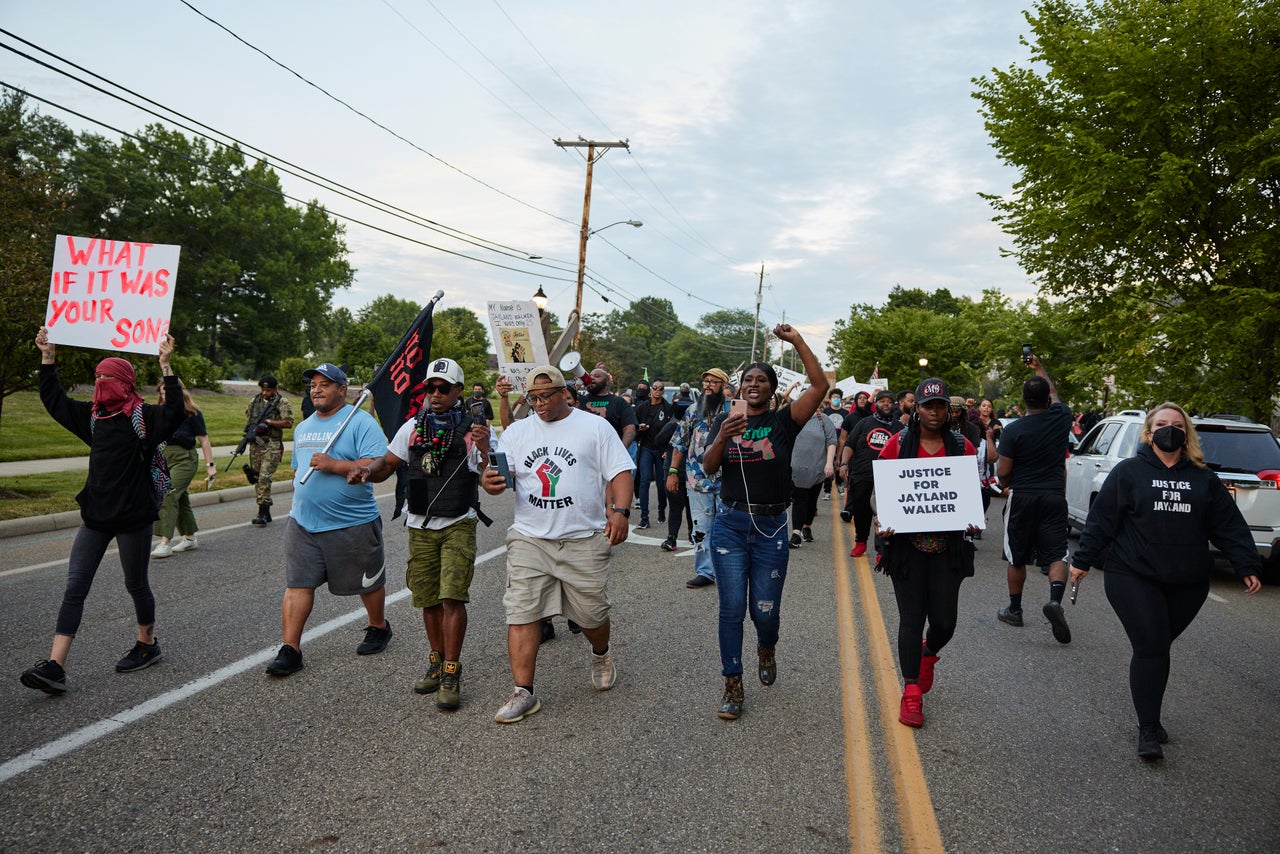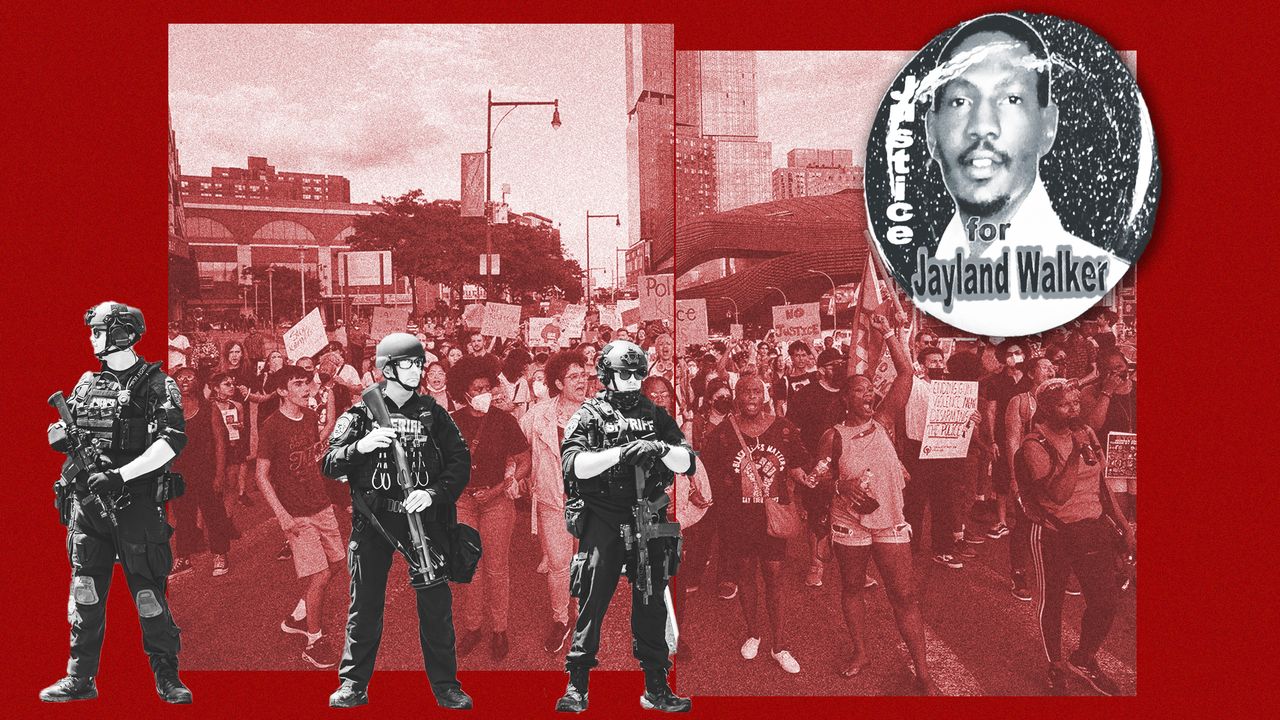On June 27, a minor traffic stop cost a Black man his life.
Jayland Walker, 25, was pulled over by police in Akron, Ohio, for unspecified traffic and equipment violations. He took off, and police later said that Walker fired a shot as he was driving away from officers. During the nearly 3-minute chase, he left his car, which was still moving.
Eight police officers fired an estimated 90 shots at Walker after they attempted to electroshock him. A gun was found inside his car, but he was shot away from the vehicle after fleeing and no weapon was found on him when police arrived and handcuffed him. Walker was pronounced dead by medics at the scene shortly after.
Police released body camera footage of the shooting nearly a week later, on July 3, and widespread protests forced the cancellation of the city’s July 4 weekend events.
On Friday morning, the Summit County medical examiner released an autopsy report concluding that Walker was shot or grazed 46 times by Akron police.
Walker is just one of almost 600 people who have been killed since 2017 after being stopped by police for only a minor violation. Earlier this year, a police officer in Grand Rapids, Michigan, was charged with second-degree murder in the death of Patrick Lyoya, a 26-year-old Black man and Congolese refugee. The officer initiated a traffic stop over an unregistered license plate, and after a brief struggle, shot Lyoya in the back of the head.
Using deadly force on an unarmed person who is fleeing is unconstitutional. In 1985, the Supreme Court ruled in Tennessee v. Garner that police officers can’t use deadly force in these situations unless police have probable cause that a threat was apparent. But that caveat allows wide wiggle room for police to claim they encountered a threat, and Akron police are sure to cite the alleged shot fired from Walker’s car, even though he was later found to be unarmed.
“Police discretion is so broad that they can justify their actions a lot of times in some way,” said Miltonette Craig, a criminal justice professor at Sam Houston State University in Texas. “Unless we have things like bodycam footage and bystander video recording to piece things together — their discretion works in their favor in a lot of these cases.”
And the act of fleeing itself is, in some states, a felony. That’s the case in Ohio, where Walker was killed. Experts say that not only does this trigger some police defenses for using lethal force, but it escalates simple fleeing offenses into high-stakes situations where a lot can go wrong.
“There is an example of the law [that] is misaligned with reality,” said Nikki Jones, a professor of African American studies at University of California, Berkeley.
“The law does not offer protection [for Walker], it offers protection for officers using force,” Jones said. “And the perception by the officers was that Jayland Walker was a threat, but it does not take the perspective that Jayland Walker saw them as a threat.”

In Michigan, where Lyoya was killed, fleeing and eluding police is considered a Class H felony, which carries a sentence of up to two years in prison.
“There is reason to think that when laws classify a behavior as felonious, the enforcement of those laws intensifies,” said TaLisa Carter, an assistant professor at American University in the department of justice, law and criminology. “Just as when laws relax around certain offenses, the way police respond to those actions also relaxes.”
The legal definition of when police can use lethal force is important, but the mindset of many police toward fleeing suspects remains dangerous even in states where it is not a felony. In Maryland, fleeing police is a misdemeanor, but in February, Baltimore police fatally shot Donnell Rochester, a Black teenager, as he was fleeing a traffic stop while driving. While the department said the car was driving toward the officer and struck him, body camera footage showed Rochester driving and the officer never being hit. Initial police accounts also gave conflicting stories as to what actually happened around Rochester’s fatal incident, casting room for doubt.
Some cities, like Washington, have instituted “no-chase” policies which would prohibit most police car chases. The policy, which came out of a reform commission following the murder of George Floyd in Minneapolis, cited the case of Karon Hylton-Brown, a Black man who was riding a scooter while being chased by D.C. police and died after he was hit by a driver. Jeffrey Price died after he was struck by a D.C. police car in May 2018 while riding his dirt bike. The family filed a lawsuit saying police engaged in a pursuit and blocked him on purpose — leading to his death.
Chicago also instituted its no-chase-on-foot policy in June. The change came after the high-profile 2021 shooting of Adam Toledo, a 13-year-old who was fatally shot by a Chicago cop.
Though Ohio laws remain strict, there have been small steps to change how police pursue fleeing people.
In 2019, Republican Gov. Mike DeWine requested that the Ohio Collaborative Community-Police Advisory Board create a new law enforcement standard for vehicular pursuits. The police advisory board was developed in 2016 while DeWine was serving as the state’s attorney general.
The advisory board was tasked with issuing guidelines to local departments and recommendations on policies police should consider when developing their own standards around vehicle pursuits.
“Regardless of which agency is responsible for responding to traffic stops, it is critical that our goal should be for everyone involved to be alive at the end of the interaction.”
- TaLisa Carter, an assistant professor at American University
Some of the recommendations included police discontinuing vehicle pursuits to ensure the safety of officers and bystanders.
“This law that exists in Ohio can be used to say, they acted in the scope that was given to me by the legislature, where they won’t be disciplined,” Craig told HuffPost. “If you pass a law that is giving too much power in terms of decision-making and the shields an officer can have against some time of disciplinary action or criminal proceeding, it looks like they can get away with whatever behavior they want.”
In December, Ohio lawmakers were also pushing legislation to ban police officers completely from pulling over drivers for minor violations.
Carter, who agreed officers should not be a part of stops and should have better discretion on vehicle and foot pursuits, emphasized that minor violation stops should not lead to death in any instance. “Regardless of which agency is responsible for responding to traffic stops, it is critical that our goal should be for everyone involved to be alive at the end of the interaction,” Carter said.
Police experts are still looking for ways to circumvent deadly chases and fatal traffic stops. One way, according to Kelcie Ralph, a transportation scholar at Rutgers University, are traffic cameras.
Traffic stops are the most common interactions between police and citizens, Ralph said. And a cop does not have to be involved every single time someone may have a minor violation with their vehicle.
“This is disproportionate policing and there are a lot of traffic stops for very minor and non-safety issues. This would add no human, in-person interaction. It would only be a camera,” Ralph told HuffPost. “The police make a lot of choices about whom they pull over. There is a tendency to pull over minority communities to a greater degree, it is no surprise that the same laws are not being influenced the same ways in affluent white communities like they are in Black and brown communities.”
Criminal justice advocacy groups have proposed other ways to remove police from traffic stops.
In 2021, the Vera Institute of Justice released a report where the group said “non-police first responders” should be specifically tasked with handling minor traffic violations and stops.
“Cities can replace police with unarmed, civilian traffic response units, housed in a city department of transportation or public works and staffed by experts in transportation and mediation,” the report said.
Last year, Berkeley, California, city officials voted to pass a recommendation for police officers to no longer focus on traffic stops for low-level offenses, like not wearing a seat belt or having expired tags. The suggestions came in a “reform package” that was passed after the city cited disproportionate stops of Black and brown people in the area.
These policies could have wide-ranging effects for people who live in those cities.
“[A traffic stop] does not feel good to the people who are being policed, and it has a potential to escalate,” Craig said. “We don’t want people to be in fear that something as small as that can result in their death, as we have seen.”
A funeral was held for Walker on Wednesday. No city officials attended. Eight officers who fired the shots at Walker have been placed on administrative leave.
CLARIFICATION: An earlier version of this article misattributed a quote about fears surrounding minor police stops. The statement had been made by Miltonette Craig, not TaLisa Carter.
